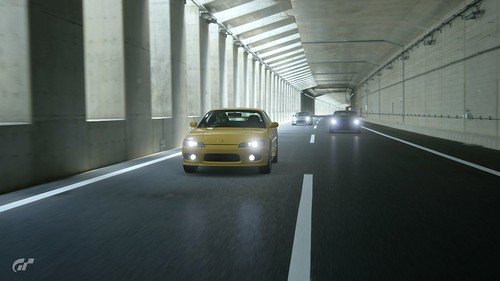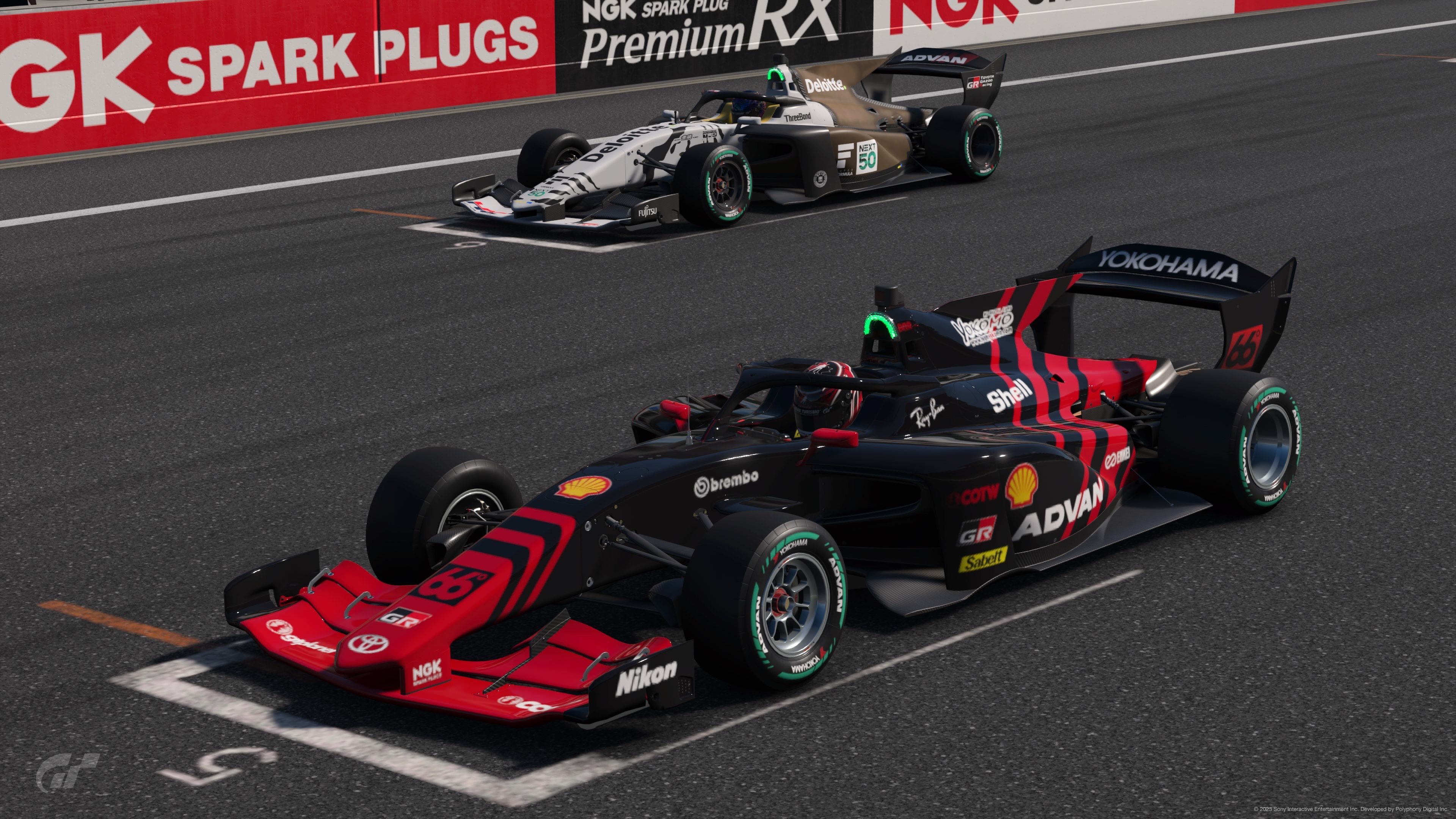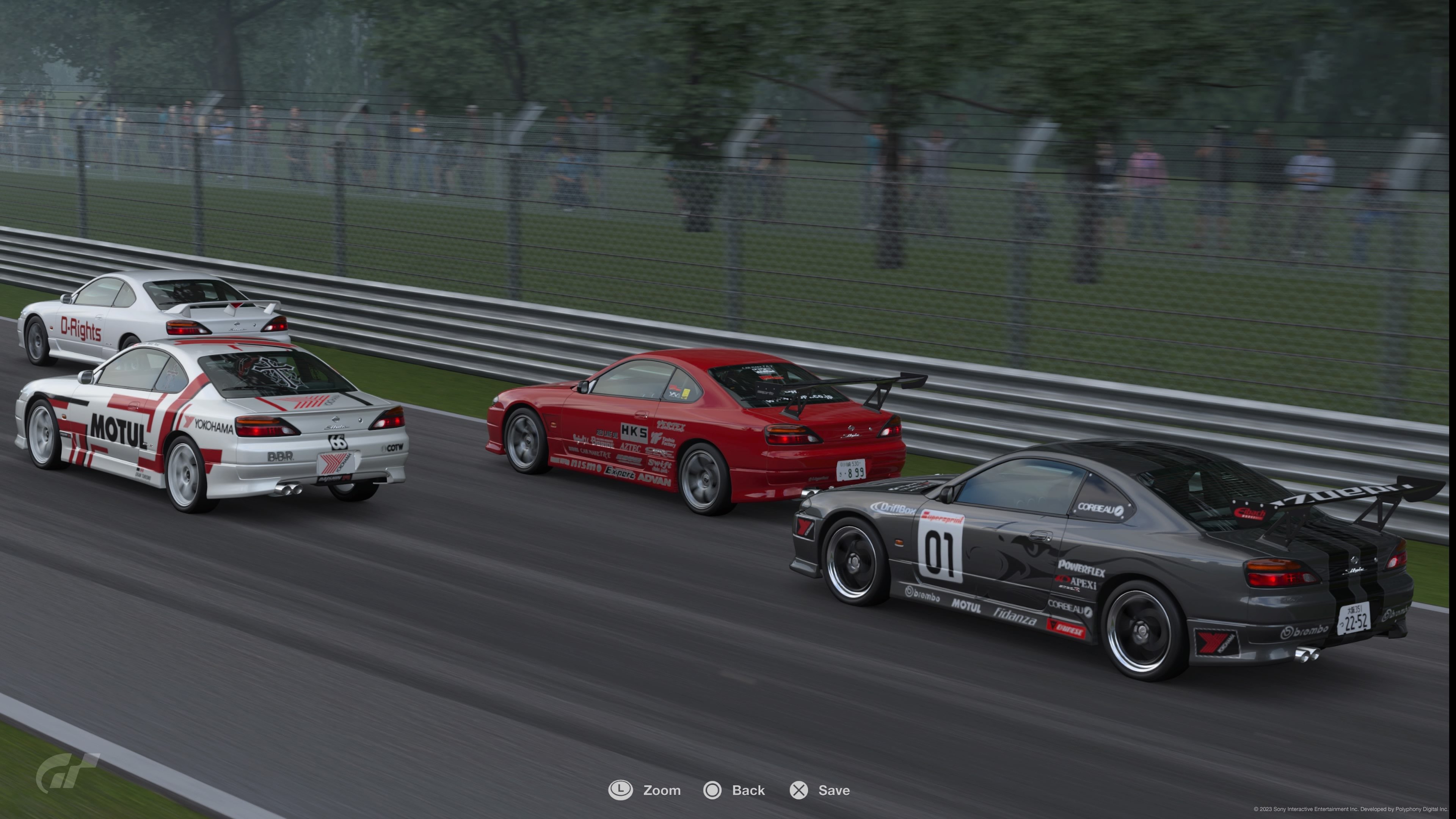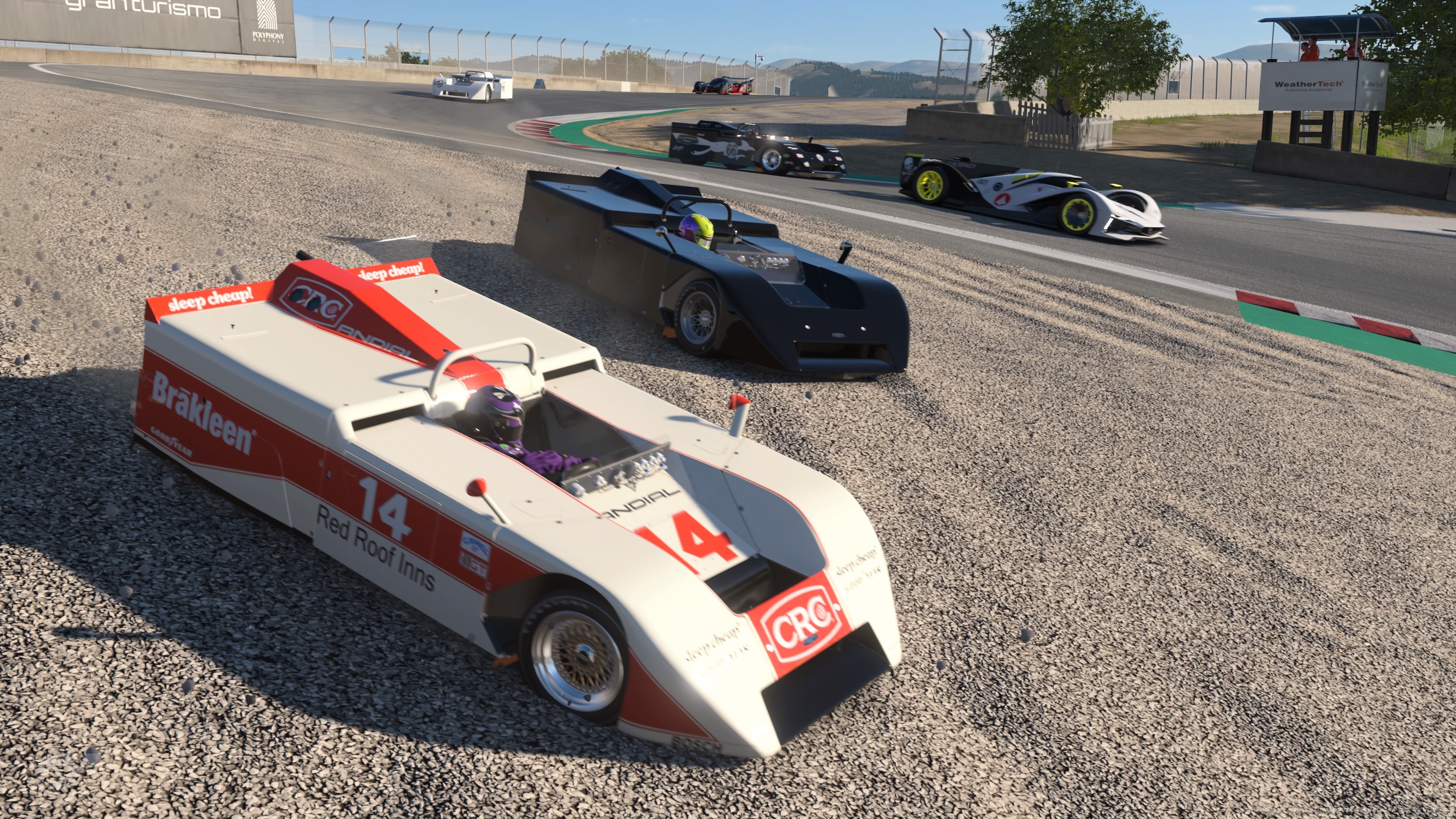GT7 Car of the Week
Week 12 - 1970 Chaparral 2J
Somewhere in Seven Haven…
A pair of hands shake me awake and the first thing I’m met with is the overly excited expression of XSquareStickIt. He’s shouting something at me, but I hear nothing. I am deaf, after all. He grabs my shoulders and shakes me more, getting more animated by the second.
“Let me put my **** hearing aid on, man.” I grumble in his general direction, which gets him to back off. I sit up, grab my cochlear implant, and put it on my head. The moment the ‘powered on’ beep sounds and the mic cuts in with the sounds of the world, I am met with the incredibly loud rumble of a V8 mixed in with an obnoxious whine that I recognize from somewhere.
“Square, what the Hellcat did you bring in here?!” I yell over the noise.
“No time to explain, follow me!” he yells back, running out of the room.
I get out of my bed, quickly throw on my worn sneakers on and run out to-
“Hey, you mind telling me what the -”
“Watch your language!”
I turn to see Es walking to me. She sighs.
“Did Baron’s air horn earlier not wake you up?” she asks, walking past me towards the idling car.
“Es, you know I’m deaf,” I reply, instinctively touching my ear to make sure my cochlear implant processor is still in place.
She pauses then looks back at me.
“You never told me, Obelisk.”
“It’s in my employee records. It’s also on the admin access card you printed for me back when the Mexico branch opened.”
“Right. I’ll check those later.”
She’s definitely not going to bother.
“So what’s with the…” I start, then stop. I take another look at the Chaparral.
Hold on. Chaparral… Chaparral?! As in-
“I have so many freaking questions right now how did you get this over here how did you get permission how did you do the legalpaperworkwhatwerethefeesisthisgoingtocutintothemexicobudget-”
“Calm down,” Es says, stopping me cold again. “In order: we shipped it via C130 in a special crate; I personally called Jim Hall and the Petroleum Museum to get permission; I did the legal paperwork the way I normally would; you don’t want to know the fee and yes it is coming out of the Mexico budget.”
“Dammit. Wait- Jim Hall himself personally approved this?” I say, feeling the excitement and adrenaline spilling into my veins.
“Yes, he sure did. Go get dressed, Obelisk. It’s time to meet your hero.”
I genuinely have no idea where I want to start with this. Like, I have so many things I want to say about this week’s car. It’s… honestly incredible that I’m finding myself at a loss for words, but I think that’s reflective of the car itself. So, let’s start from the top.
This week's Car of the Week is the 1970 Chaparral 2J. We’ve all encountered it in some capacity - some of us first encountered it as a potential opponent in the American GT Championship back in GT4. Some of us first found it in GT5’s UCD. Some of us first encountered it after getting soundly thrashed in an online lobby by it in either GT5 or GT6.
The point is, we all know of the Chaparral 2J and its penchant for absolutely annihilating races both online and offline in games past. It’s taken a break to get a model refresh, and now it’s here in GT7. To get it, you either purchase it from the Hagerty’s Legend Car Dealership or by winning all gold across the “The Sun Also Rises” missions. It’s fairly cheap for a LCD car, with some early guides indicating a price of 2.5 million credits, though keep in mind that this will fluctuate up and down with every appearance in the LCD.
Enough of the gameplay stuff, I’ll get to that later - there are much bigger questions here! The first is “What is that thing?”; the second is “Why is it boxy?”, and the third is “How does it work?”. The answer to all three is a long story, so get yourself a nice cup of your favorite drink and a warm treat… and enjoy what may be the deepest dive ever done on COTW.
Do note that this is a truncated summary from various second and third hand sources (i've done a lot of research to cross-verify) and some minor details that clarify on certain things may have been missed/put aside.
Section 1: The men behind Chaparral
To understand the 2J, we need to understand Chaparral Cars. To understand Chaparral Cars, we need to understand the men who started it all.
Enter Jim Hall and Hap Sharp, the founders of Chaparral.
Hap Sharp, born 1928 and died 1993, was a well-off businessman who ran Sharp Oil and first entered racing in the 1950s… in boats. C Hydro class boats, specifically. He eventually won the US National Outboard Racing Championship. During this time, he found his passion for cars and started going to driving school in 1957 on the advice of a friend.
By 1959, he had his own mechanic and was racing in a Cooper Monaco T49 which had its original engine tossed and replaced with a 2.3 liter Maserati 4-cylinder engine; he ultimately won the Bahamas Speed Week and at Road America.
He then jumped into Formula 1 in 1961 and 1962, with his best finish being 7th place in the 1963 Mexican GP.
During this time, he also took on sports car racing. He, together with Jim Hall, won the 1962 Road America 500 in as well as multiple podiums and wins between 1962 and 1965 in their various Chaparrals.
Hap ultimately retired from racing in 1965 with two final commitments/substitutions with Chaparral in 1966 and 1967.
His partner in racing and fellow co-founder was Jim Hall, who I am surprised to learn is still alive. He’s 87 years old as of the time I write this.
Jim Hall was born in 1935 and as he grew up, he was accepted into Caltech (California Institute of Technology). It was during his time at Caltech that he started to race in local sports car racing. During the 1950s, a promised job at General Motors (to work on the Corvette - oh, what could’ve been…) fell through, and he started working in Dallas with his brother.
…At none other than Carroll Shelby Sports Cars. This job proved to be crucial to his development as a driver, as a common stunt Shelby would pull was to put Jim Hall in one of the new racers he was selling then send Jim off to win races. He’d then brag that if a rookie could go out and win in said car it was an outstanding piece of machinery.
It didn’t take long for people to notice Jim Hall’s abilities as a driver. He got international attention at the 1960 US GP when he took his (past-its-prime) Lotus-Climax and held onto 5th place for almost the entire length of the race. A few laps from the end, his car’s differential failed and he ended up 7th.
After the race, Jim Hall was approached by a pair of car builders who had an idea for a front-mid engined two-seater racing car. Hall agreed to fund the builders’ project and a new car was born.
The new car’s name?
The Chaparral.
Section 2: Chaparral Cars, early innovation
After buying two
Chaparral 1s and racing with them from roughly 1960 to 1962, Jim and Hap decided they loved the concept of Chaparral and wanted to make their own improved version.
And so Chaparral Cars came to be in 1963, with their first car being the
2A. Two copies of it were made, both weighing 715 kg and powered by mid-mounted Chevy small-block 327s mated to 2-speed autos.
Yes. Automatics. No, I don’t know why.
Anyways, the 2A and its evolution the
2B (which is hard to identify, as the cars were constantly being iterated on) came out of the gate with the first notable innovation from Chaparral: the use of fiberglass as a chassis material.
According to
this website, the two Chaparral 2As fielded had 24 wins, 16 2nd place and 5 3rd place finishes between them. This was across 45 races between 1963 and 1965.
The
2C, which was concurrent in 1965, participated in five races and completed three. It won its very first race. Not… much to write home about. The 2C weighed 750 kg and was powered by the same 327 as the 2As had equipped.
The
2D, which featured in Gran Turismo 4, Gran Turismo 5 and Gran Turismo 6, was a conversion of the 2A designed to tackle endurance racing. It was the first Chaparral to feature a closed top. Among the changes made to it was the 327 small-block being replaced by a Chevy big-block 427, upping the power to 420 HP.
The 2D landed Chaparral’s first win outside of America, cinching a win in the 1966 1000km of Nurburgring.
During this early development of the Chaparral cars, Hall also took part in tire development with Firestone, as he owned a race track next to his base of operations in Midland, Texas. Around the same time, a two-part article was released by Car and Driver featuring Hall’s design theories on vehicle design and handling; this attempt at turning speculation into applied physics formed the early foundation for what would become modern data collection and management that many racing teams still use to this day.
Things began to change when Jim Hall decided to present his theories to the world in practice rather than on paper…
Section 3: Paradigm Shift
In 1966, Hall and Sharp revealed the
Chaparral 2E, a new design based on advanced theories of aerodynamics developed by Hall. It marked a radical shift in motorsports, and it was shocking to look at thanks to the massive wing mounted on struts that towered over the back of the car. The wing was linked to a pedal in the cockpit of the car. When fully depressed, the wing would sit perfectly flat and reduce drag on the car. Essentially, a primitive form of DRS that proved very effective at the time.
That year, the 2E would win two races and get three 2nd place finishes out of 8 total races. Pivoting wings on struts were copied by many other teams shortly after this, and the accidents that resulted from it led to the design being banned.
Its successor, the
2F, was essentially the concepts of the 2E transplanted onto one of the two 2D conversions. The engine was upgraded to a 7 liter big-block engine, which unfortunately proved to be too much for the transmission. The car was still able to win one race, the 6 Hours of Brands Hatch in late 1967. The FIA banned the 2F along with the GT40 and 330 P4 following this year.
The
2G, a development of the 2E, took part in 13 races and got 5 podiums across those events. By this time, the changes to the car put too much strain on the chassis (originally the 2C chassis), and the only reason it stayed competitive was due to Jim Hall’s skill behind the wheel.
Around this time, Hall noticed that the downforce he was generating was also creating a lot of drag, so he designed the super streamlined
Chaparral 2H for the 1969 to try and work around this. Unfortunately, he suffered an accident before the 1969 season and had to bring another driver in to go through the season. The driver, John Surtees, was very unhappy with the car and demanded a redesign (ruining the point of the car) and ran the rear wing at max attack, leading the car to be uncompetitive.
Are you all still with me?
Okay, good. Cliff notes of the innovative things Chaparral have done so far, from 1963 to 1967:
- Fiberglass chassis
- Tire development with Firestone
- Early foundations of data collection and applied physics in motorsports
- First use of a wing to generate downforce to create grip (forever changing the landscape of motorsports)
- First use of DRS
Still with me?
Good. It only gets more wild from here.
Section 4: Mechanical Insanity
Now we finally get to the subject of the post: the
1970 Chaparral 2J.
It looked nothing like any of the other cars on the grid. Quoting Blake Zong’s
2017 article on the 2J:
“The small white race car atop the trailer looked like nothing else: no wing, no velocity stacks, no scoops or side pods or wild cutaways or NACA ducts, hardly a curve of any kind. The rear wheels were encased in bodywork as flat and unadorned as a diner kitchen. "Like the box it came in," the crowd observed. They moved to the back of the car: two fans like jet engines, supported by three black Dagmar-shaped cones, looking more like a Star Wars escape pod than a road-going automobile.
Who knows what the crowd must have thought. Who knows what the other drivers and team managers and pit chiefs must have thought. Dear God! Can-Am was famous for having no-holds-barred technical expertise, but this was something else: every other car looked like phallic fantasy, all elongated curves and swoops and short, stubby wedges, like 6th-grader math class daydreaming rather than real race cars, but here the Chaparral 2J was square, bulky, straight-paneled and utterly, breathtakingly, rational. The crowd had seen nothing like it.”
And that’s just the beginning.
The Chaparral 2J had two engines in it. The primary engine that powered the wheels was a 650-680 HP aluminum ZL1 (a 427 engine) mated to a 3 speed automatic. The secondary engine was a 247cc Rockwell JLO two-stroke.
“But Obelisk,” I hear you, “why did it need two engines?”
Because of the fans. The JLO engine was mated to a pair of fans mounted to the rear of the car. Originally from an M-109 Howitzer, the fans could theoretically push out 9,650 cubic inches per minute (158,135 cubic centimeters per minute for metric folks) at 6,000 RPM. It was rumored that the fans were powerful enough to push the car to 40 MPH on their own.
This was paired with a very complex system of pulleys, cables and arms that were attached to several Lexan panels mounted to the sides and rear of the car. The pulley system was designed to maintain a uniform height between the Lexan panels and the ground regardless of the car’s orientation.
What is the point of all of this complexity?
The simple answer is “ground effects”.
When the fans are started up, a vacuum is created under the car and pulls it to the ground.
The process has the side effect of lowering the car by two inches.
The net result is a car that can generate 2,200 lb of downforce while parked.
A ton of downforce. Without any movement.
The car purportedly could pull up to 1.5gs in a turn, and was said to have no wheelspin or oversteer.
A journalist noted that Chaparral could have parked the car on a ceiling and unveiled it that way - and technically speaking, he was 100% correct.
Unfortunately, the 2J wasn’t quite ready. At Watkins Glen, Jackie Stewart qualified third but ultimately had to withdraw because the JLO overheated, followed by the brakes failing. At Laguna Seca, the 2J broke the overall lap record in qualifying then promptly threw a connecting rod through the engine block the next day. At Riverside, the final race of the season, the crankshaft on the JLO failed before the race and had to be fixed. The JLO then died for good on the second lap of the race.
Following this, McLaren protested to the SCCA. They argued that the fans constituted “movable aerodynamic parts” (a load of crap) and…
Let me just cite the Wikipedia statement on this. Just… trust me.
“McLaren argued that if the 2J were not outlawed, the Can-Am series would be ruined by its dominance – something McLaren had been doing since 1967.”
The SCCA caved. The 2J was banned forever.
Chaparral Cars shut down shortly after that, though they did see a brief revival in the late 1970s to 1990s in Indycar, with the all-new Chaparral 2K. They won the 1980 CART Championship and the Indianapolis 500 the same year.
Chaparral would also later be briefly revived in a special collaboration with Chevrolet to produce the
Chaparral 2X Vision Gran Turismo, exclusive to Gran Turismo 6, Sport and 7.
The surviving Chaparral cars (2A, 2D, 2E, 2H, 2J, 2K + Corvette GS-II test car) are maintained by, and displayed at, the Permian Basin Petroleum Museum in Midland, Texas, USA.
A virtual 360 degree gallery is available.
So… Gameplay.
In game, as previously mentioned, the car is obtainable from the LCD for 2.5 million credits, or from getting gold in The Sun Also Rises (where it is featured in one mission).
The car finds itself at 863 PP, coming in the box (yes that is intentional) with 683 horsepower and tipping the scales at a meager 1,810 lbs or 821 kilograms. That's 2.65 lb / hp or 1.2 kg / hp. Mind you, McLaren's dominant (and lethal¹) M8D, at the time powered by a similar Chevy engine, weighed some 500 pounds lighter at 1,380 lbs.
The 2J is powered by a 7.6 liter V8 powering the rear wheels via a 3 speed semi-automatic transmission.
The Lexan panels are correctly depicted in-game; just watch the car in 3rd person going down a really bumpy stretch of road. You'll see the car itself responding to the bumps, but the panels will maintain their strict gap to the road surface below.
The first thing I want to mention off the bat: This car may be older than half of the COTW crew, but it is absolutely not a clunker.
On the factory transmission, 0-60 is 3.25 seconds on RS tyres, and the 1,000 m run is around 205 MPH. On the custom 5 speed you can equip, it hits 0-60 in 3.1 seconds and hits 202 mph in the 1,000 m run.
What makes this car truly unique is the benefits conferred to it by the always-on downforce. The 2J has the highest low-speed lateral Gs of any car that is not the F1 cars, the x2019 or the Tomahawks:
And for comparison, from Gr. 1:
The 2J's gearbox, due to being semi-automatic, has the sequential gearbox behavior where shift time is practically instantaneous, so there is zero interruption in the power delivery.
The handling is incredible. The car is very responsive to driver input and darts side to side like nothing else in the game. If you're driving it like any other high power RWD and not mashing the throttle at every opportunity, it rewards you double by grabbing the road surface and accelerating like a bat out of hell on corner exits. You get this weird mix of extreme grip and short wheelbase responsiveness, but it does come at the cost of the car being quick to panic in certain situations. It can snap pretty hard, especially in places that seem rather unusual. For example, certain crests at Road Atlanta and the Le Mans circuit. It also doesn't take too kindly to the steep banking at Daytona, requiring that you be very, very precise with your steering input to keep it from getting upset.
So, to really see what it can do, I took the 2J to Road Atlanta to compare to its closest peers: Group 1. The cars I chose are the XJR-9 and the Peugeot VGT - the latter being considered one of the best cars in Gr. 1. I gave them all RH tyres and ripped them until I felt I couldn't reliably improve their times.
And the winner of this shootout?
I'll keep this brief: The car is incredibly fast even all the way down at 800pp - being an incredible choice for the WTC800 at Sardegna. It used to be detunable all the way down to 425/450 pp and used in the one hour Alsace race.
Essentially, barring some very specific tracks and race conditions (nighttime), the Chaparral 2J is one of the best cars you can get your hands on under 900 PP, and it will punch up no matter what.
And it gets even better with the custom racing transmission that adds two gears to it. A lot of its twitchiness is taken straight out of the equation when you give it appropriately spaced gear ratios. It can hit a drag limited top speed of 245 to 250 MPH!
The only problems I can really name with the car that CANNOT be bypassed via good driving skills are:
- The brakes are kinda awful for a car this fast. Learn to work with the braking distance and it'll make up the difference everywhere else.
- Very high speed lateral Gs are poor as the car isn't doing much to generate additional high speed downforce. You'll plow through some turns that more modern cars can deal with flat out.
It's a shame there aren't more events that it can enter.
And it's a shame the technology got shafted. The car was so far ahead of its time that we are only just now seeing a resurgence in fan car technology with modern monsters such as the McMurtry Speírling and the Murray T.50. Over 50 years later!
Some say it's the wildest racing car to ever come out of American Motorsports. I disagree.
It's one of the wildest racing cars to ever exist,
period.
So what is the Chaparral 2J?
It's the washing machine. The vacuum cleaner. Or as GT7 dubs it, The White Winged Beast.
It is Jim Hall's magnum opus. The ultimate middle finger to the rules and regulations and a master stroke in the beginning stages of a revolution of motorsports.
And even now, some 53 years later, it is still an
unstoppable Sleeper.
¹Bruce McLaren was killed June 2, 1970 when the M8D he was testing had its rear aero rip apart at 170 mph.
EDIT:
Great supplemental video by Donut breaking down some of the decisions that went into the 2J.












































































































































